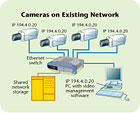ANSWERS BELOW.
- Digital systems represent video information through electrical signals with continuously varying levels.
- True
- False
- An electronic device or technique that compresses and decompresses digital signals is called a:
- CD-RW.
- Codec.
- DAT.
- GUI.
- A technology that connects a number of hard drives into a single mass storage device is called:
- HDD.
- ISDN.
- PSTN.
- RAID.
- None of the above
- Which of the following is an advantage of digital CCTV over analog CCTV systems?
- Faster searches
- Copies of images can be made without any degradation in quality
- Ease of sending images to third parties
- Multiple cameras can share a common cable
- All of the above
- M-JPEG and MPEG are identical compression techniques.
- True
- False
- Which of the following factors can affect the file size of a digital image?
- Compression technique
- Refresh rate
- Resolution
- All of the above
- Typically a VCR with a 16-camera multiplexer set to 24-hour mode will record less than one frame per second.
- True
- False
- Connecting multiple digital cameras to an existing network can adversely affect the per-formance of the network.
- True
- False
- Which of the following cable types can be used to connect a digital camera to an existing LAN?
- RG-59U
- RG-6U
- Cat 3
- Cat 6
- Any of the above
- Depending on the equipment used, the bandwidth consumed by a digital CCTV system may be adjusted to accommodate the LAN requirements.
- True
- False
- The cameras in an IP-based digital CCTV system can be viewed over a:
- LAN.
- VPN.
- Internet.
- Any of the above
- None of the above
- PoE allows analog cameras to be connected to a digital CCTV system.
- True
- False

What’s Wrong with This?
Wally `Larman installed a four-camera network digital video system with the cameras connected to the customer’s existing LAN. Wally used the correct cable and terminators, connecting the four digital cameras to an existing network switch that had available ports, as shown in this diagram. (For simplicity, only the basic LAN devices are shown.) Wally then programmed each camera’s IP address to the IP address of the manager’s PC, but when Wally tried to test the system, he ran into trouble. Can you see what Wally did wrong and what he must do to correct the problem?5-Minute Tech Quiz Answers
Here are the answers to the 5-Minute Tech Quiz and What’s Wrong with This? that appears on page 33.- b – Digital systems transmit data as ones or zeros. Analog systems transmit video information with continuously varying levels.
- b – Codec is short for compress/decompress.
- d
- e – Additionally, network CCTV allows you to use the existing network cabling for the video images and to use standard network storage devices to archive and access video images.
- b
- d
- a
- a – Connecting digital cameras to an existing network requires the use of some bandwidth of the network to transmit images. If the network does not have sufficient capacity, adding video can slow the network down. You should speak to the IT manager before connecting any video devices to the network.
- d
- a – Some digital systems allow you to throttle or limit the amount of bandwidth that they will use.
- d
- b – PoE, Power over Ethernet, allows you to use a single network cable and connection for both video and power.



